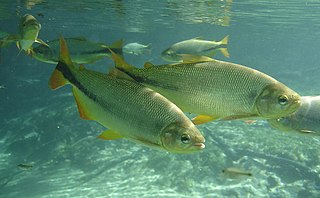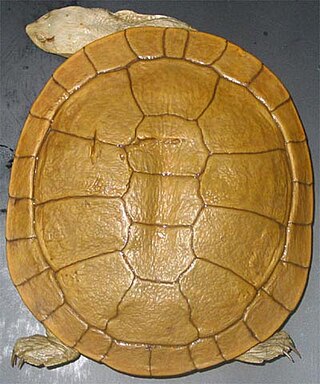
Franz Steindachner was an Austrian zoologist, ichthyologist, and herpetologist. He published over 200 papers on fishes and over 50 papers on reptiles and amphibians. Steindachner described hundreds of new species of fish and dozens of new amphibians and reptiles. At least seven species of reptile have been named after him.

Leporinus is a genus of fish in the family Anostomidae native to South America. The fossil species Leporinus scalabrinii, known from the late Miocene of Entre Ríos in Argentina, has only recently been added to this genus after being misidentified as a species of primate under the name Arrhinolemur scalabrinii for over 100 years.

The Doradidae are a family of catfishes also known as thorny catfishes, raphael catfishes or talking catfishes. These fish are native to South America, primarily the Amazon basin and the Guianas.

The wattle-necked softshell turtle, also commonly known as Steindachner's soft-shelled turtle, is an endangered Asian species of softshell turtle in the family Trionychidae. The species is the only member of the genus Palea.

Rineloricaria is a genus of freshwater tropical catfish belonging to the family Loricariidae. They are commonly called whiptail catfish because of the long filament that grows out of the tip of the caudal fin that is characteristic of the genus. With the exception of R. altipinnis from Panama, they are native to the rivers of northern and central South America. Some species are regularly seen in the aquarium trade.

Telestes is a genus of cyprinid fish. It was formerly usually included in Leuciscus.

Farlowella is a genus of fish in the family Loricariidae native to South America. This genus is broadly distributed in Amazon, Orinoco, Paraná and coastal rivers of the Guyana Shield. It is absent from the Pacific slope of the Andes and from the coastal rivers of the Brazilian Shield. Many of these species are kept in aquariums. This genus has a unique body shape that resembles a thin stick of wood. The body is slender and elongate, often with a pronounced rostrum and a brownish color with two lateral dark stripes beginning at the tip of the rostrum, passing over the eyes and ending at the tail, which are periodically interrupted on the caudal peduncle.

Olyra is a genus of catfishes of the family Bagridae. This genus occurs throughout South Asia and western Indochina, from India to western Thailand.

Pristobrycon is a genus of piranhas from the Orinoco and Amazon Basins, as well as rivers in the Guianas.

Cathorops is a genus of catfishes in the family Ariidae found in the Atlantic and Pacific Oceans. These species are found in the eastern and western Central and South America in brackish and freshwater habitats. This genus is a strongly supported clade of this family. It consists of a natural group in which the monophyly is well-defined by morphological and molecular evidence and the genus probably includes several unrecognized species from both American coasts.

Brycon is a genus of fish in the family Characidae found in freshwater habitats in Central and South America, ranging from southern Mexico to northern Argentina. Despite not being closely related to true trout, they are sometimes called South American trout. Members of the genus may be referred to by a number of other different common names in various languages. They reach a maximum length of 11.9–79.5 cm (4.7–31.3 in) depending on the species involved. Some species perform seasonal breeding migrations.

Pimelodella is a genus of three-barbeled catfishes.

Scarus is a genus of parrotfishes. With 52 currently recognised extant species, it is by far the largest genus in this family. The vast majority are found at reefs in the Indo-Pacific, but a small number of species are found in the warmer parts of the eastern Pacific and the western Atlantic, with a single species, Scarus hoefleri in the eastern Atlantic. Most are very colourful, and have strikingly different initial and terminal phases. Adults of most species reach maximum lengths of between 30 and 50 cm (12–20 in), but the rainbow parrotfish can grow to lengths of 1.2 m (3.9 ft).

Chaetostoma, also known as the bristlemouth catfish, is a genus of suckermouth armored catfishes native to South America with one species, C. fischeri, extending into Panama. Most species inhabit flowing rivers in the lower Andes and its foothills. Some species are kept in unheated aquaria.
Luciobarbus is a genus of ray-finned fishes in the family Cyprinidae. Its members are found in fresh and brackish waters of southern Europe, northern Africa, the wider Near East, the Aral and Caspian Seas, and rivers associated with these. Several species in the genus are threatened. Most species are fairly small to medium-sized cyprinids, but the genus also includes several members that can surpass 1 m (3.3 ft) in length and the largest, the mangar can reach 2.3 m (7.5 ft).

Prochilodus is a genus of freshwater fish from the family Prochilodontidae. This family include two other genera, Ichthyoelephas and Semaprochilodus, which have been included in Prochilodus instead. The greatest species richness of Prochilodus is in river basins in eastern, southeastern and southern Brazil, but there are also species in the river basins of the Amazon, Guianas, Colombia, Venezuela, Paraguay and northeastern Argentina. The largest species in the genus reach about 80 centimetres (2.6 ft) in length, but most species barely reach half that size.

The blind goby is a species of fish in the goby family, the only species in the genus Typhlogobius. It is native to the coastlines of southern California in the United States and Baja California in Mexico, where it commonly inhabits the burrows of shrimp of the genus Callianassa. The adult of the species is completely blind and lacks pigmentation, while the juvenile has rudimentary eyes that help it find the shrimp burrows. This species can reach a length of 8.3 centimetres (3.3 in) TL.

Chelodina steindachneri, commonly known as the dinner-plate turtle, Steindachner's turtle and or Steindachner's flat-shell turtle, is a species of turtle in the family Chelidae. The species is the least known of the Australian turtles and also one of the smallest members of the long-necked turtles of the genus Chelodina. It is a member of the subgenus Chelodina making it closely related to the Chelodina longicollis group of species.

Opsodoras stuebelii, the Maranon thorn catfish, is a species of thorny catfish from the family Doradidae which is found in the Amazon Basin in Bolivia, Brazil, Colombia, Ecuador and Peru. It is the type species of the genus Opsodoras.

Geophagini is a tribe of cichlids from the subfamily Cichlinae, the American cichlids. It is the sister taxon to the clade which includes the Cichlasomatini and Heroini. Fishes in the Geophagini are distributed from Panama south to Argentina, it is the most speciose of the seven tribes within the Cichlinae and it is subdivided into three sub-tribes, Acarichthyina, Crenicaratina, and Geophagina which together contain over 200 species. Geophagines show morphological and behavioural specialisations to enable them to sift the substrates within their mouths so that they can separate benthic invertebrates from substrates dominated by sand or silt.



















